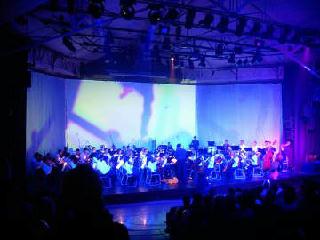Theory / Research
RAEWYN TURNER
TRANSLATIONS INTO SMELL FROM LIGHT AND SOUND
Raewyn Turner combined choices of colour and smell generated from her perception of the phrases of the sound. Her first step in making a perceptual analysis of music is to make a morphological configuration of music in pauses and phrases as a description of sound. She interpreted sound to light by making a visual representation of the sound, in an intuitive drawing, putting sound into a relationship with other experiences, specifically a visual experience of light and dark. The 'sound drawing' is the basic form used to describe íphrasesí of sound in the form constants of the language of colour and light. The form constants are colour, brightness, movement, perspective, symmetry, replication and afterimage. Phrases of the sound were coded into light, the pauses into dark, so making correspondences between sound/silence and light/dark.
The process of translation to smell involved finding proportional relationships between light and dark (rhythm), colour and sound pattern (signal), and smell (memory language). Central to this is that light acts as a pigment switch to whatever verdant matter it is connected to i.e., seed, germination, pollination. For reference a chart was made of the daytime and nighttime hours and latitudes of the pollination period for a wide selection of flowering plants which are available as essential oils. The approximate central point of an area (mean latitude)World Book, Atlas, 1986, where those plants are harvested for their essential oil, and the time of harvest of those plants in that area,were used to find the mean daylight and night-time hours over that period The American Ephemeris Nautical Almanac Annual Publication (2002) ĎTable of Sunrise and Sunsetí (local mean time).
The smell elements within the range of matching proportional comparisons are chosen for their pitch - high, medium and base notes.
Method of translation used in the 2002 Four Senses Concerts:
Proportional comparisons based on duration of piece of music and latitude periodicity
for example: 'Brahms Hungarian Dance 10'
Proportions of dark to light events in music
Duration in seconds of the entire piece of music = 110 seconds
Divide above by 2 = 55 seconds
Divide total by the sum of dark events = 5 seconds = 11
Proportion of dark to light = divide by 10 = 1.1
Refer to the pollination chart showing the list of plants with corresponding pollination times, night time and daytime hours. Find the proportion of night hours to daylight hours by dividing daytime hours by night time hours.
Match the proportions of night hours to daylight hours (of an essential oilís pollination time and latitude at which this occurs) with the proportions of dark to light events in piece of music to obtain a range of corresponding proportional comparisons.
Refer to chart of proportions of night hours to daytime hours
chart: no. 3 = 1.1 = 20íN
20íN, India: holy Basil (^), angelica root (o), champaca (o), frankincense (#),
frangipani (o), jasminum (o), musk mallow (#), amamthus (o), patchouli (o#), rose attar (o), rose indian (o), sandalwood (o#), tuberose (o#), tuberose (o#)
10íN Somalia: myrr (#)
10íN Thailand
13íN Vietnam: caleput (^)
13íN Cambodia
10íN Philippines: elemi (#)
9íN Ethiopia: frankincense (#)
10íN Nigeria
10íN Costa Rica: cardamon (^o)
11.30íN Sudan
8íN Ghana: cocoa extract (o#)
The selection provided an olfactory pitch range.
Olfactory Pitch ^ (top), o (middle), # (bass)


